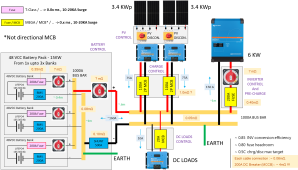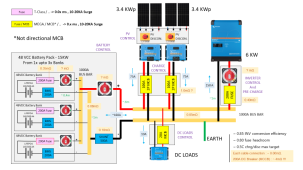Hi,
recently joined this wonderful forum
I've spent some time already reading threads on the subject, the very useful filterguy's guides and Victron's "Wiring Unlimited"..
i've made a sketch of my plan for the DC side for my project.
While i was initially thinking to use MCCB(s) on the battery side, in the likes of what Andy (offgridgarage) does
i've then changed my mind.. mainly due to the high resistance those devices introduce.. which is gonna consume lot of W and create heat on the path
However here is my current sketch of the DC side and i indeed welcome any feedback exp if something doesn't look as it should
( i didn't include wires sections cse the drawing was already crowded enough..)
I'll likely start with one battery bank and add the others relatively after
Thanks

recently joined this wonderful forum
I've spent some time already reading threads on the subject, the very useful filterguy's guides and Victron's "Wiring Unlimited"..
i've made a sketch of my plan for the DC side for my project.
While i was initially thinking to use MCCB(s) on the battery side, in the likes of what Andy (offgridgarage) does
i've then changed my mind.. mainly due to the high resistance those devices introduce.. which is gonna consume lot of W and create heat on the path
However here is my current sketch of the DC side and i indeed welcome any feedback exp if something doesn't look as it should
( i didn't include wires sections cse the drawing was already crowded enough..)
I'll likely start with one battery bank and add the others relatively after
Thanks




